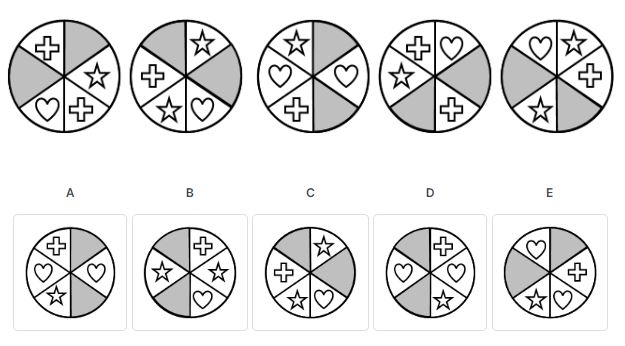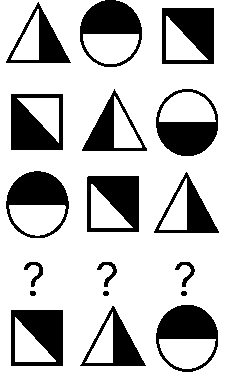Welcome to JobTestPrep’s Free Abstract Reasoning Test Practice! If you're preparing for an abstract reasoning test, you're in the right place.
This free abstract reasoning practice test will help you enhance your pattern recognition and analytical thinking skills, both of which are essential for excelling in assessments used by top employers.
Master abstract reasoning skills, develop quicker problem-solving abilities, and approach your test with confidence.
Why the Abstract Reasoning Test Matters
Why the Abstract Reasoning Test Matters
The abstract reasoning test is a crucial component in many pre-employment assessments. Unlike tests that measure verbal or numerical knowledge, abstract reasoning assesses your cognitive abilities, including pattern recognition, logical thinking, and problem-solving skills.
Employers in various fields, such as tech, finance, consulting, and more, frequently use abstract reasoning tests to assess how well you can process and analyse new information, adapt to challenges, and make sound decisions.
By practising with our abstract reasoning practice test, you’ll improve these skills and be better prepared for your assessment.
Pass Your Abstract Reasoning Test
Whether you're preparing for an abstract reasoning test for a specific job or just looking to improve your cognitive abilities, JobTestPrep is your go-to resource.
Our PrepPacks are designed to provide you with the best possible preparation, featuring expert-created content and practice questions.
Start practising today and take the first step toward acing your abstract reasoning test!
Free Abstract Reasoning Practice Questions
Get familiar with the types of questions you might face in your abstract reasoning test. We’ve selected authentic questions from our comprehensive Abstract Reasoning PrepPack to help you get started.
Next In Series Questions
Next in Series questions test your ability to identify patterns and predict the next item in a sequence. These questions often involve rotations, colour changes, and other visual patterns.
Sample Question 1:
Choose the image that completes the pattern (From left to right):

Ace Your Job Search with a Custom Prep Kit
Job hunting doesn't have to be stressful.
Prepare smarter and ace your interviews faster with our Premium Membership.



Sample Question 2:
Choose the image that completes the pattern (From left to right):

Tip: The main challenge associated with Next In Series questions is the way in which they push the line between objective and subjective interpretations. Test takers are likely to find rules that are based on things they have seen before, and less likely to find rules that are anchored in themes and concepts they are unfamiliar with. To easily locate the sole correct interpretation, it is helpful to familiarise yourself with the type of patterns test publishers like to include.
Want to Practise Next In Series Questions?
You can use our unique Abstract Reasoning Practice Pack, which features comprehensive prep material for these types of questions.
Matrices Questions
Matrices questions require you to identify patterns both horizontally and vertically. These questions are usually more complex than Next in Series questions because they involve multiple patterns.
Sample Question 3:

Choose the correct three figures to complete the sequence:

Sample Question 4:

Which of the following boxes should replace the question mark (?) to complete the pattern?

Sample Question 5:

Which of the following boxes should replace the question mark (?) to complete the pattern?

Sample Question 6:
The following test shape belongs to:

Sample Question 7:

Which of the following boxes should replace the question mark (?) to complete the pattern?

Matrices are generally considered more difficult than Next In Series questions because the pattern isn't necessarily linear. The advantage with matrices, however, is that more images give you more context to try and understand the pattern. All-in-all, matrices are a formidable but surmountable challenge.
Practise Matrix Questions with Our PrepPack
A Matrix is a collection of separate images that follow a specific pattern. It is up to you to figure out which image will appear next by understanding the pattern.
Matrices are one of the most commonly used drills for abstract reasoning, appearing in tests such as the Alva Labs Test, Matrigma Test, and Raven's Progressive Matrices (RPM).
Odd One Out Questions
Odd One Out questions ask you to identify the figure that does not belong in a set based on logical reasoning.
Sample Question 8:
Choose the odd one out:

In contrast to Matrices and Next in Series questions, odd one-out questions require deductive reasoning as well as inductive reasoning. The key is to identify a rule that describes all but one figure, and then determine which shape differs from the others in the series.
Analogies Questions
Sample Question 9:
Which option completes the sequence best?

Sample Question 10:
Which option completes the sequence best?

For analogy questions, look for the relationship between the two shapes in the first pair. Identify how the shapes differ (e.g., in size, shading, rotation, or shape). Then, apply the same change or pattern to the second pair. This will help you select the option that completes the analogy logically.
Master Abstract Reasoning with JobTestPrep
To excel in your abstract reasoning test, consistent practice is key. JobTestPrep's Abstract Reasoning PrepPack™ offers hundreds of practice questions, full-length simulations, expert study guides, and detailed explanations to help you hone your skills.
By practising with our abstract reasoning practice tests, you can:
- Master pattern recognition
- Develop faster and more accurate problem-solving abilities
- Prepare effectively for real-world tests used by employers
We provide comprehensive prep resources to ensure you’re ready to tackle any abstract reasoning test with confidence.
Get started by clicking the name of YOUR abstract reasoning assessment:
| Test Description | |
|
SHL tests typically feature abstract reasoning questions. Read more about the SHL PrepPack |
SHL Practice |
|
The Saville Abstract Reasoning Test is one of a host of pre-employment aptitude tests offered by Saville. You can read more about Saville tests |
Saville Practice |
|
Aon, also known by its previous name 'cut-e', is famous for its innovative approach to testing. Read more about the Aon PrepPack. |
Aon/cut-e Practice |
|
The Alva Labs Logic test uses matrices, as seen on this page, to assess inductive reasoning. You can read more about the Alva Labs test. |
Alva Labs Practice |
|
Highly challenging, this matrix test invokes sharp logical and abstract intuition. Read about the Matrigma test. |
Matrigma Practice |
|
Yet another assessment that focuses on matrices, the Raven test is extremely ubiquitous and is the inspiration for the Talent Q Logical Assessment. Read more about The Raven's Progressive Matrices Test. |
Raven's Practice |
|
The University Clinical Aptitude Test (UCAT) is used to select applicants for medical and dental programmes. As you might expect, it is made to be quite difficult. You can read more about the UCAT. |
UCAT Practice |
|
The A-RAT 3R Abstract Reasoning Test published by Hudson is a unique test that uses its own question format. You can learn more about the Hudson Abstract Reasoning Assessment. |
Hudson Practice |
Abstract Reasoning Practice for Specific Assessments
Preparing for a specific abstract reasoning test? JobTestPrep offers prep packs for various assessments used by top employers, including:
- SHL Abstract Reasoning Tests
- Raven’s Progressive Matrices
- UCAT Abstract Reasoning
- Matrigma Abstract Reasoning Test
- Alva Labs Logic Test
- Aon/Cut-e
- Saville Abstract Reasoning Test
Each prep pack includes tailored questions and solutions specific to the test you're preparing for, helping you build the skills needed for success.
More Free Practice
We at JobTestPrep find the assessment tests world highly diverse and fascinating. If you are looking to deepen your knowledge in the aptitude tests world, or you want some extra practice before your test, we've got you covered!
Check out these fantastic free practice tests (all are completely free):
Free Aptitude Test | Free Psychometric Test | Free Numerical Reasoning Test | Free Verbal Reasoning Test | Free Cognitive Test | Free Critical Thinking Test | Free Spatial Reasoning Tets | Free Personality Test | Free Inductive Test | Free Mechanical Reasoning Test



